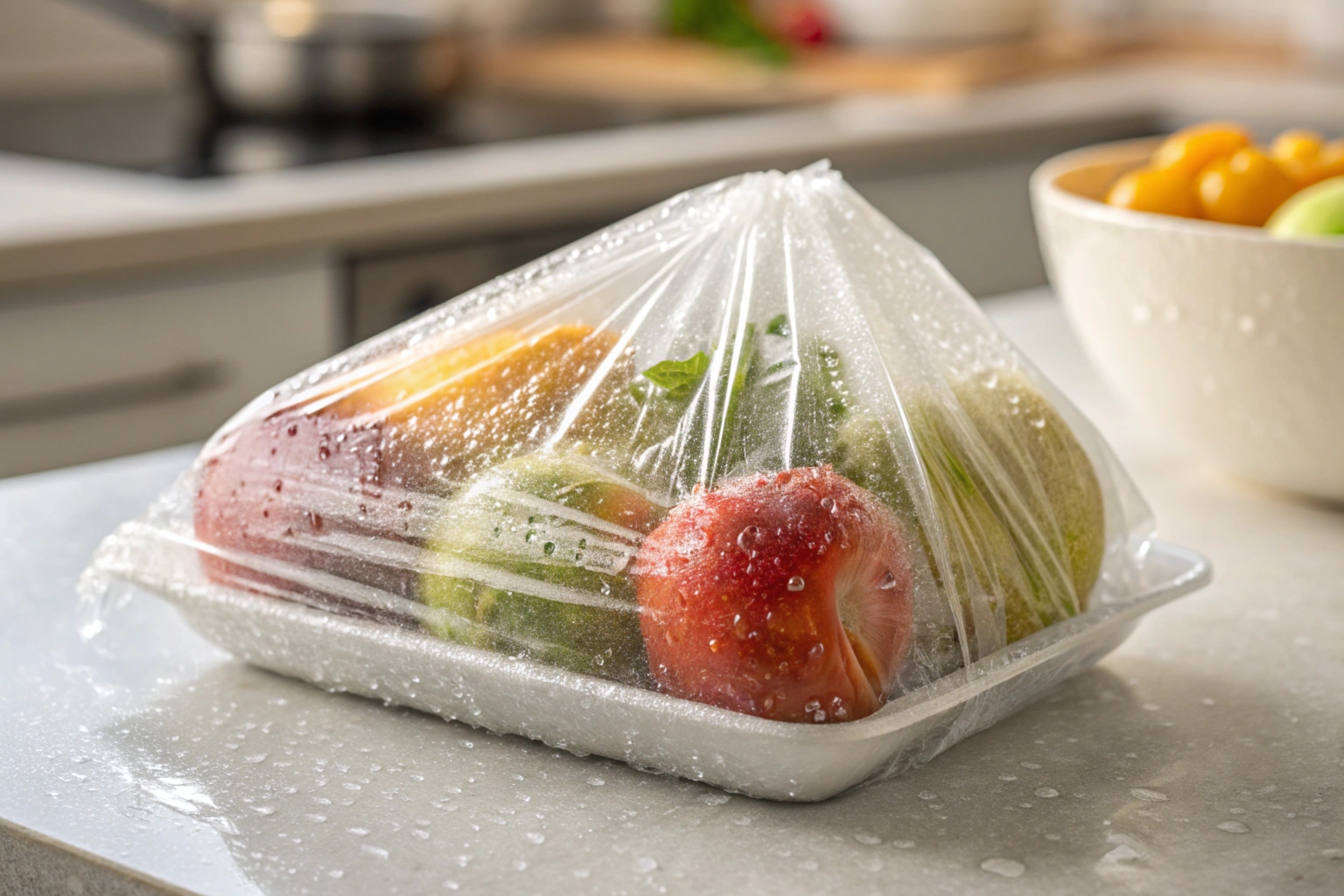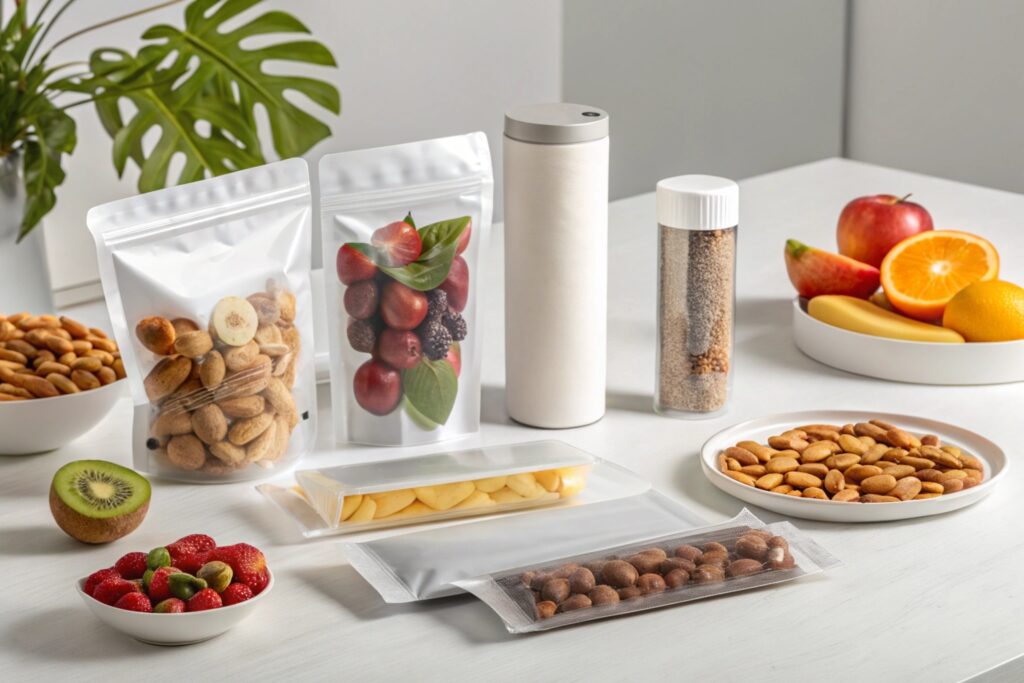When it comes to food packaging, finding the best packaging options for maintaining food freshness1 is crucial for maintaining freshness and quality. A wrong choice can lead to spoilage, waste, and unhappy customers.
The benefits of flexible packaging for food storage2 like pouches or laminated rolls make it the ideal choice for durability and customizability.
Packaging solutions have evolved to meet the needs of modern businesses and consumers. Let me take you through some options and considerations to help you decide.
What is the plastic packaging for food called?
Plastic has been a staple material for food packaging for decades. Its versatility and affordability make it one of the most used materials in the industry.
Plastic packaging for food is often referred to by its specific types, such as polyethylene (PE)3, polypropylene (PP)4, and polyethylene terephthalate (PET)5. Each type offers unique benefits for different food products.

Dive deeper: Types of plastic used in food packaging
Here are some common plastics and their applications in food packaging:
| Plastic Type | Characteristics | Common Uses |
|---|---|---|
| Polyethylene (PE) | Flexible, moisture-resistant | Snack bags, bread wrappers |
| Polypropylene (PP) | High clarity, heat resistance | Microwave-safe containers, salad boxes |
| PET (Polyethylene Terephthalate) | Strong, excellent barrier properties | Bottles, vacuum-sealed meat packaging |
Plastic packaging is customizable and lightweight, reducing shipping costs and allowing creative branding. However, sustainability is a growing concern. Recycling facilities and biodegradable options can address these challenges.
Innovations in plastic food packaging
- Biodegradable plastics: Compostable materials like PLA are gaining traction for environmentally conscious consumers.
- Multi-layer laminates: Combining different types of plastic layers ensures strength, flexibility, and improved shelf life.
- Smart packaging: Some advanced materials include embedded sensors to monitor freshness.
Understanding these advancements can help businesses choose packaging that aligns with their goals and customer expectations.
What bags are used in food packaging?
Food packaging bags are as diverse as the food products themselves. Selecting the right bag can directly impact product safety, appeal, and functionality.
Common bags used in food packaging include stand-up pouches, vacuum-sealed bags, and zip-lock bags. These options cater to different food types and storage needs.
Dive deeper: Different types of food packaging bags
-
Stand-up pouches
These are highly popular for snacks, coffee, and dry goods. Their ability to stand upright on shelves enhances visibility, and features like resealable zippers improve convenience. -
Vacuum-sealed bags
Vacuum bags remove air to preserve freshness for longer. They are ideal for perishable goods like meat and cheese.- Best for: Extending shelf life and reducing waste.
-
Flat pouches
Often used for single-serving items, flat pouches are lightweight and cost-effective.- Best for: Small quantities of chips, nuts, or condiments.
-
Specialty bags
Bags with unique features like gussets, valves, or foil linings offer specific benefits:- Gussets expand the bag for larger capacities.
- Valves allow the release of gases, perfect for coffee.
- Foil linings provide superior barrier protection.
| Bag Type | Advantages | Common Products |
|---|---|---|
| Stand-up pouches | Attractive, resealable | Snacks, coffee, pet food |
| Vacuum-sealed bags | Air-tight, longer shelf life | Meats, cheese, seafood |
| Flat pouches | Cost-effective, easy to store | Single-use snacks, sauces |
| Foil-lined bags | Excellent barrier against moisture/oxygen | Chips, coffee, powdered products |
By understanding these options, businesses can tailor their packaging to suit product needs and customer preferences.
Do food delivery bags work?
Food delivery bags have become essential in the era of on-demand dining. But do they truly serve their purpose? Let’s explore their role.
Yes, food delivery bags work effectively when they are well-insulated and designed to maintain food temperature. They keep hot foods hot and cold foods cold during transit.
Dive deeper: What makes a good food delivery bag?
The best delivery bags offer a combination of insulation, durability, and convenience. Here are key features to consider:
-
Thermal insulation
High-quality insulation materials, such as foam or reflective linings, help maintain food temperature for up to an hour.- Best for: Preserving the freshness of pizza, soups, or ice cream.
-
Waterproofing
A waterproof outer layer prevents spills or rain from ruining the food.- Best for: Protecting packaging during inclement weather.
-
Portability and durability
Comfortable handles, sturdy zippers, and reinforced seams ensure easy transport without wear and tear.- Best for: Reliable and frequent use in food delivery services.
A closer look at insulated delivery bags
| Feature | Benefit |
|---|---|
| Thick foam lining | Retains heat or cold effectively |
| Adjustable straps | Enhances carrying comfort |
| Multiple compartments | Separates hot and cold items |
Are delivery bags eco-friendly?
Sustainability is becoming a priority in food delivery. Reusable bags or those made from recycled materials are great choices for reducing environmental impact. Exploring biodegradable liners or reusable inserts can also enhance eco-friendliness.
Conclusion
Choosing the right food packaging bag is more than just a logistical decision—it’s a key part of product success. Whether you’re selecting plastic for durability, exploring specialized bags for specific needs, or ensuring delivery bags keep food fresh, the right choice will boost customer satisfaction and brand reputation.
-
Explains how different types of packaging preserve food quality, ensuring freshness and reducing waste. ↩
-
Discusses why flexible packaging, such as pouches and laminated rolls, is a preferred choice for businesses looking for durability and customization. ↩
-
This link provides detailed explanations of different types of plastics used in food packaging, helping readers understand the benefits and applications of each material. Knowing this information is crucial for making informed choices about food safety and packaging requirements. ↩
-
This link provides detailed explanations of different types of plastics used in food packaging, helping readers understand the benefits and applications of each material. Knowing this information is crucial for making informed choices about food safety and packaging requirements. ↩
-
This link provides detailed explanations of different types of plastics used in food packaging, helping readers understand the benefits and applications of each material. Knowing this information is crucial for making informed choices about food safety and packaging requirements. ↩


